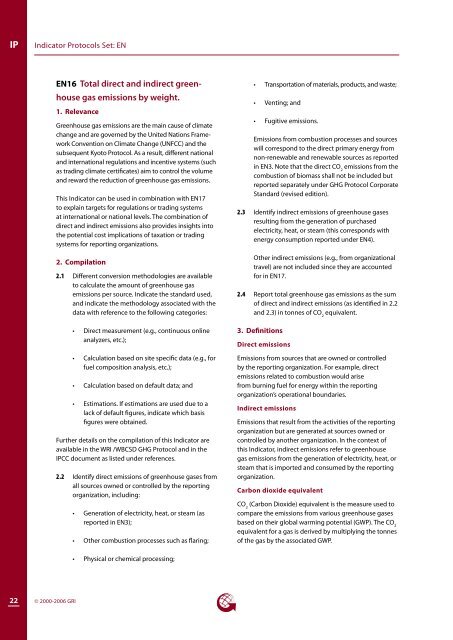Environment - Global Reporting Initiative
Environment - Global Reporting Initiative
Environment - Global Reporting Initiative
You also want an ePaper? Increase the reach of your titles
YUMPU automatically turns print PDFs into web optimized ePapers that Google loves.
IP<br />
Indicator Protocols Set: EN<br />
EN16 Total direct and indirect greenhouse<br />
gas emissions by weight.<br />
1. Relevance<br />
Greenhouse gas emissions are the main cause of climate<br />
change and are governed by the United Nations Framework<br />
Convention on Climate Change (UNFCC) and the<br />
subsequent Kyoto Protocol. As a result, different national<br />
and international regulations and incentive systems (such<br />
as trading climate certificates) aim to control the volume<br />
and reward the reduction of greenhouse gas emissions.<br />
This Indicator can be used in combination with EN17<br />
to explain targets for regulations or trading systems<br />
at international or national levels. The combination of<br />
direct and indirect emissions also provides insights into<br />
the potential cost implications of taxation or trading<br />
systems for reporting organizations.<br />
2. Compilation<br />
2.1 Different conversion methodologies are available<br />
to calculate the amount of greenhouse gas<br />
emissions per source. Indicate the standard used,<br />
and indicate the methodology associated with the<br />
data with reference to the following categories:<br />
• Direct measurement (e.g., continuous online<br />
analyzers, etc.);<br />
• Calculation based on site specific data (e.g., for<br />
fuel composition analysis, etc.);<br />
• Calculation based on default data; and<br />
• Estimations. If estimations are used due to a<br />
lack of default figures, indicate which basis<br />
figures were obtained.<br />
Further details on the compilation of this Indicator are<br />
available in the WRI /WBCSD GHG Protocol and in the<br />
IPCC document as listed under references.<br />
2.2 Identify direct emissions of greenhouse gases from<br />
all sources owned or controlled by the reporting<br />
organization, including:<br />
• Generation of electricity, heat, or steam (as<br />
reported in EN3);<br />
• Other combustion processes such as flaring;<br />
• Transportation of materials, products, and waste;<br />
• Venting; and<br />
• Fugitive emissions.<br />
Emissions from combustion processes and sources<br />
will correspond to the direct primary energy from<br />
non-renewable and renewable sources as reported<br />
in EN3. Note that the direct CO 2<br />
emissions from the<br />
combustion of biomass shall not be included but<br />
reported separately under GHG Protocol Corporate<br />
Standard (revised edition).<br />
2.3 Identify indirect emissions of greenhouse gases<br />
resulting from the generation of purchased<br />
electricity, heat, or steam (this corresponds with<br />
energy consumption reported under EN4).<br />
Other indirect emissions (e.g., from organizational<br />
travel) are not included since they are accounted<br />
for in EN17.<br />
2.4 Report total greenhouse gas emissions as the sum<br />
of direct and indirect emissions (as identified in 2.2<br />
and 2.3) in tonnes of CO 2<br />
equivalent.<br />
3. Definitions<br />
Direct emissions<br />
Emissions from sources that are owned or controlled<br />
by the reporting organization. For example, direct<br />
emissions related to combustion would arise<br />
from burning fuel for energy within the reporting<br />
organization’s operational boundaries.<br />
Indirect emissions<br />
Emissions that result from the activities of the reporting<br />
organization but are generated at sources owned or<br />
controlled by another organization. In the context of<br />
this Indicator, indirect emissions refer to greenhouse<br />
gas emissions from the generation of electricity, heat, or<br />
steam that is imported and consumed by the reporting<br />
organization.<br />
Carbon dioxide equivalent<br />
CO 2<br />
(Carbon Dioxide) equivalent is the measure used to<br />
compare the emissions from various greenhouse gases<br />
based on their global warming potential (GWP). The CO 2<br />
equivalent for a gas is derived by multiplying the tonnes<br />
of the gas by the associated GWP.<br />
• Physical or chemical processing;<br />
22<br />
© 2000-2006 GRI

















